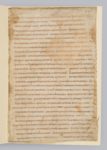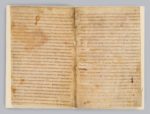
Basil, Homeliae in Psalmos (fragment), c. 750–800 [MS40A]
Probably French
Manuscript on vellum, ff. 3. Bound in grey-blue card covers, 20th century (30 x 19.7 cm)
These three leaves are the oldest manuscript fragments in the Fellows’ Library. They once formed part of the binding of MS40, a 12th-century copy of Palladius’s De Agricultura. The pages were cut to fit the binding, with losses along the bottom edge and down one side.
The text is part of Basil of Caesarea’s (330–379) homily on Psalm 1, translated from Greek into Latin by Tyrannius Rufinus (c. 344–411). It is written in an uncial script, a style of writing commonly used from the 4th to the 8th centuries and consisting entirely or mostly of capital letters. Here, a few letters appear in their half-uncial (lower case) form. In many places, the scribe has not included breaks between words. This feature, known as scriptio continua (continuous script), was typical of scribal practice in ancient Rome and continued into the early medieval period.
These fragments are rare survivals. Fewer than two thousand Latin manuscripts, in whole or in part, date from before AD 800. Some of these, like the Lindisfarne Gospels or the Palatine Virgil, are famous and beautiful books that have been treasured for centuries. Many others, including these fragments, survive only because they were reused as binders’ waste.
Literature: Elias Avery Lowe, Codices Latini Antiquiores, vol. 2 (Oxford, 1935), no. 261; Neil R. Ker and Alan J. Piper, Medieval Manuscripts in British Libraries, Volume IV: Paisley–York (Oxford, 1969), p. 628; Paul Yeats-Edwards, Winchester College (Warden and Fellows’ Library) Medieval Manuscript Collection: Brief History and Catalogue (London, 1978), p. 9.
Provenance: Unknown, used as waste in the late 16th-century binding of MS40 and at Winchester College by 1634.
Location: Fellows’ Library

